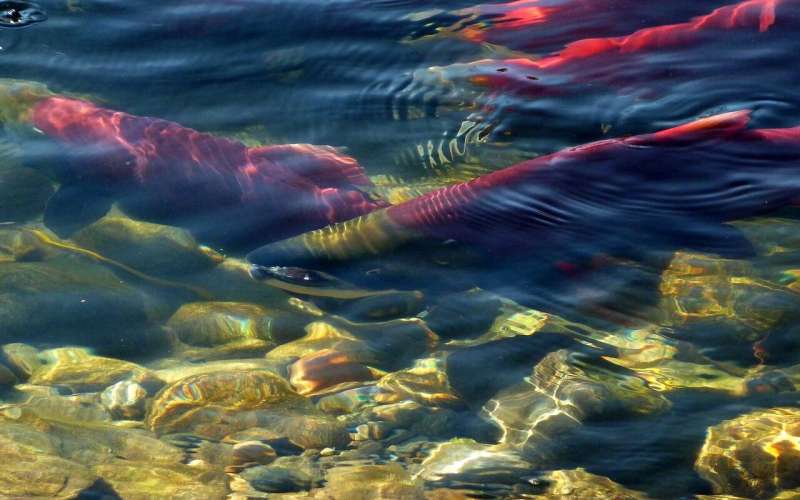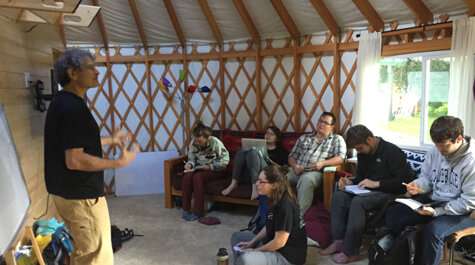Salmon Tales: Sex, myth and molecular genetics of an iconic fish

A sockeye salmon's life ends right back where it began, culminating in an anadromous drama of sex, decay and sacrifice.
Patty Zwollo says that it's all part of sexual maturation in salmon: They swim up out of the Pacific into the same streams in which they were born and into the lives, literature and religion of the native peoples of the drainages.
Zwollo, a professor in William & Mary's Department of Biology, team-taught a summer salmon-centric class with Carey Bagdassarian, senior lecturer in interdisciplinary studies at the university's Roy R. Charles Center. They took seven W&M undergraduates to Alaska for the COLL 300 class Salmon Tales: Biology, Complexity and Story. It's the second year for this immersive examination of salmon, offering looks at topics ranging from molecular genetics to mythology.
"We start off with the whole idea of story," Bagdassarian said. He explained that the students read the Barry Lopez essay "Landscape and Narrative," which discusses the resonance between the outside landscape and an individual's inner psychological landscape.
"So we frame the course like that," he said, "this idea of story—internal, or external—and as we build from the cellular level, to the organism level, to the ecosystem level, to the story level, and then to the cultural level."

Zwollo takes the lead on salmon investigations at the cellular level. She is an experienced salmon researcher, studying the salmon immune system at various locations in the Kenai River drainage. She has identified three sites from which the undergraduates can study salmon at the apex of their migration, and so the date for the Salmon Tales is selected carefully.
"The first week of August," she said, "because I know those three sites. I've been going to those three sites for years and that's the safest window for us to be able to go to all three."
The idea is to allow the students to see the sockeye on their spawning beds, known as redds. The spawners are creating a new generation of salmon with their literal last gasps. All the Pacific species of salmon die soon after spawning.
"When the students dissect these fish, they see the fish are full of worms," Zwollo said. "Some of them have lots of fungus. So, you can see that the fish aren't doing so well anymore."
Zwollo and Bagdassarian have arrangements with local wilderness guides who harvest their specimens fresh from the river—if a spawned-out, rotting salmon could be described as "fresh."
"I have research permits from the department of fish and game up there, so I'm allowed to get so many fish per site," Zwollo said. "They snag the salmon, one at a time. And the students weigh the fish, they observe the health of the fish and they dissect the fish. We look at the immune organs and we physically remove those."
"They said 'thank you' to the salmon for their sacrifice for science," Bagdassarian added.
The remains of the specimen fish are returned to the river, to join the carcasses of their brother and sister salmon in the food chain, many of them dragged out of the water by bears and other animals, eventually becoming part of the landscape as they decompose and provide nutrients to the trees.
The students take the blood and organ samples back to the yurt that serves as a combination classroom/headquarters/laboratory. They use assays that Zwollo has developed to measure the amounts of specific antibodies as a kind of capstone experience that draws on the molecular lecture that came at the beginning of the experience.
"It's linked to a central hypothesis that I've been working on," Zwollo said. "Basically, the reason that salmon go back to their natal streams to spawn is because they have made the right combination of antibodies. They're kind of vaccinated to the pathogens of the natal ground by the antibodies. And that's why I needed to explain it at the molecular level in the beginning lecture, so the students could understand—and appreciate how amazing it all is."
Salmon Tales is a popular interdisciplinary experience, drawing many more applicants than the allotted class size of seven. It's a COLL 300 class, which are experiences designed to introduce students to global or cross-cultural issues. The class was supported by the Charles Center at William & Mary. "The Charles Center paid for 50 percent of the student cost. That's impressive," Zwollo said.
Zwollo and Bagdassarian interviewed all the interested students separately and each of them compiles a top ten list. "And amazingly enough, for the second year in a row, we had the same top 10 list," Bagdassarian said.
Assignments for the seven students began before the flight to Alaska. The seven—Emilie Bjerring '20, Zach Cooper '21, Deniz Kosereisoglu '20, Susannah Lohmann '20, Jordan Martin '20, Justin Mitchell '20 and Daniel Villegas '21—read stories from the Haida tradition. Bagdassarian explained that the stories were chosen to illustrate aspects of salmon that resonate with the human consciousness.
"These stories—originally oral poems transcribed to paper in the early 1900s—revolve around gift-giving, sacrifice and rebirth," he said, "and these themes speak directly with the salmon story."
Bagdassarian asked the students to re-read the stories once they got to Alaska, which brought on a different sort of discussion than in the classroom.
"You do this on the land; you do this while seeing salmon, and it's so different," he said. "It's so different than seeing them sit talking about it in class or watching a video or looking at a picture."
The Salmon Tales faculty say that there are a number of aspects of the salmon lifecycle that humans have found compelling. One is the idea of sacrifice, and a second is how they find their way back to their home streams. Zwollo said 99 percent of sockeye return to the very water in which they started life.
"But we also talk about the strays," she said. "the salmon that don't make it; the ones that go somewhere else. Having strays is important for the population. Because if the natal grounds are destroyed, the strays can start a population somewhere else.
"No biological system is perfect, right? So there's a possibility for change."
Provided by The College of William & Mary


















